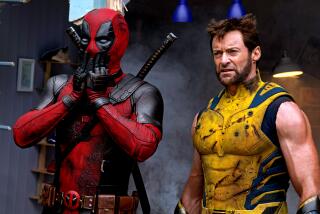Studios Look to Television’s Vaults for Box-Office Gold
- Share via
Paramount’s back-to-back TV-bred blockbusters, “Star Trek: First Contact” and “Beavis and Butt-head Do America,” have refocused the spotlight on the movie industry’s efforts to squeeze fresh dollars from familiar television properties.
Paramount leads the way in turning small-screen entertainment into theater fodder, not only in the number of adaptations but also in overall success. That status has received a major boost from the eighth “Star Trek” movie (gross to date: $85 million) and the animated teen comedy ($41 million and counting). But the studio may eventually get a healthy shove from rival Universal Pictures, which ranks second in the TV-into-movies category but holds the biggest trove of unexploited old shows, analysts say.
“If you just thought you were sick of seeing all these TV shows on the big screen, well . . . get used to it. This is just the beginning,” says veteran industry analyst Hal Vogel, of New York-based Cowan & Co. “Universal has an untapped TV library and [corporate parent] Seagram’s knows it. That’s one of my selling points on [its] stock. . . . Disney doesn’t have that much to offer. Paramount is pretty much getting tapped out. MGM/UA has the ‘Pink Panther’ and little else.” (MGM is also adapting “Sea Hunt.”)
According to Entertainment Data Inc. (EDI), the average domestic gross for a film adapted from TV in the ‘90s has been about $65 million, compared to an average of $34 million for all films released in 600 theaters or more.
“That’s the reason for all of this,” said Marcy Polier, founder and president of EDI. “It pays . . . a sure bet. It’s easy to market, the audience already knows the characters and understands the premise, it’s pretested and the audience is built in.”
So with visions of “Beavis and Butt-head”-size opening weekends dancing in their heads, studio bosses are willing to suffer flops such as “Kids in the Hall: Brain Candy” or “Flipper.”
In the early part of the decade, about four TV adaptations a year made it into theaters. In the past couple of years, according to EDI, the figure has doubled, with Paramount having released 18 such films in the ‘90s, or about 35% of the total.
The 48 TV adaptations tracked by EDI since 1990 have grossed about $2.5 billion domestically, with no aggregate overseas number available. Until recently, a Paramount executive said, such films had trouble overseas because the audiences hadn’t been exposed to many of the shows.
Studios have made hay with movies such as “Casper” and “The Flintstones” (Universal); the “Batman” series, “The Fugitive” and “Maverick” (Warner Bros.).
In the Paramount pack: the “Addams Family,” “Wayne’s World” and “Brady Bunch” films and sequels as well as last summer’s blockbuster “Mission: Impossible,” directed by Brian De Palma--who earlier turned onetime TV staple “The Untouchables” into a hit movie.
The industry woke up to the burgeoning overseas potential of these spinoffs with the 1994 release of “Star Trek Generations,” the series’ seventh installment. It grossed $30 million abroad.
“Until the last ‘Star Trek,’ the international marketplace was virtually nonexistent for the ‘Star Trek’ series, or for most of these TV adaptations for that matter,” said Wayne Lewellen, head of Paramount distribution. “The reason is really pretty simple. There was no TV penetration in the rest of the world. But all the changes in the last few years with TV syndication have completely changed that. Audiences in those territories can beam in these old shows now and that has made an incredible difference in our business.”
Flops do occur, of course. Among them, for example, these 1994 releases: Paramount’s “Lassie,” which grossed only $9.9 million domestically; Orion’s “Car 54, Where Are You?,” which took in a paltry $1.2 million; and Buena Vista’s “It’s Pat,” a spinoff of a “Saturday Night Live” skit that tanked quickly with a minuscule $60,000.
Another “Saturday Night Live” spinoff, Paramount’s “Stuart Saves His Family” (built around Al Franken’s Stuart Smalley character) came out in April 1995 and grossed less than $1 million; Universal’s “Flipper” took in less than $20 million last summer; and “Sgt. Bilko” bumbled in at about $30 million. Even superheroes aren’t immune: Warner Bros.’ 1993 cartoon “Batman: Mask of the Phantasm” bombed with just $5.6 million, hardly keeping with the Dark Knight’s live-action franchise status.
But studios find the pre-sold nature of TV adaptations irresistible, which is why 1997 release schedules show remakes of “McHale’s Navy” and “Leave It to Beaver” (Universal), “The Saint” (Paramount), “The X-Files” (Fox) and even a live-action version of the 1960s cartoon “George of the Jungle.” In the latter case, the “George, George, George of the Jungle, watch out for that tree!” theme song may be more memorable than the program itself--a possibility underscored by the emphasis placed on the tune in Disney’s current trailer.
So when studio executives complain about having to rely on tried-and-true TV material because of a dearth of fresh scripts and new concepts, “Don’t believe it,” said a Paramount insider. “TV remakes are big business.”
More to Read
The biggest entertainment stories
Get our big stories about Hollywood, film, television, music, arts, culture and more right in your inbox as soon as they publish.
You may occasionally receive promotional content from the Los Angeles Times.










